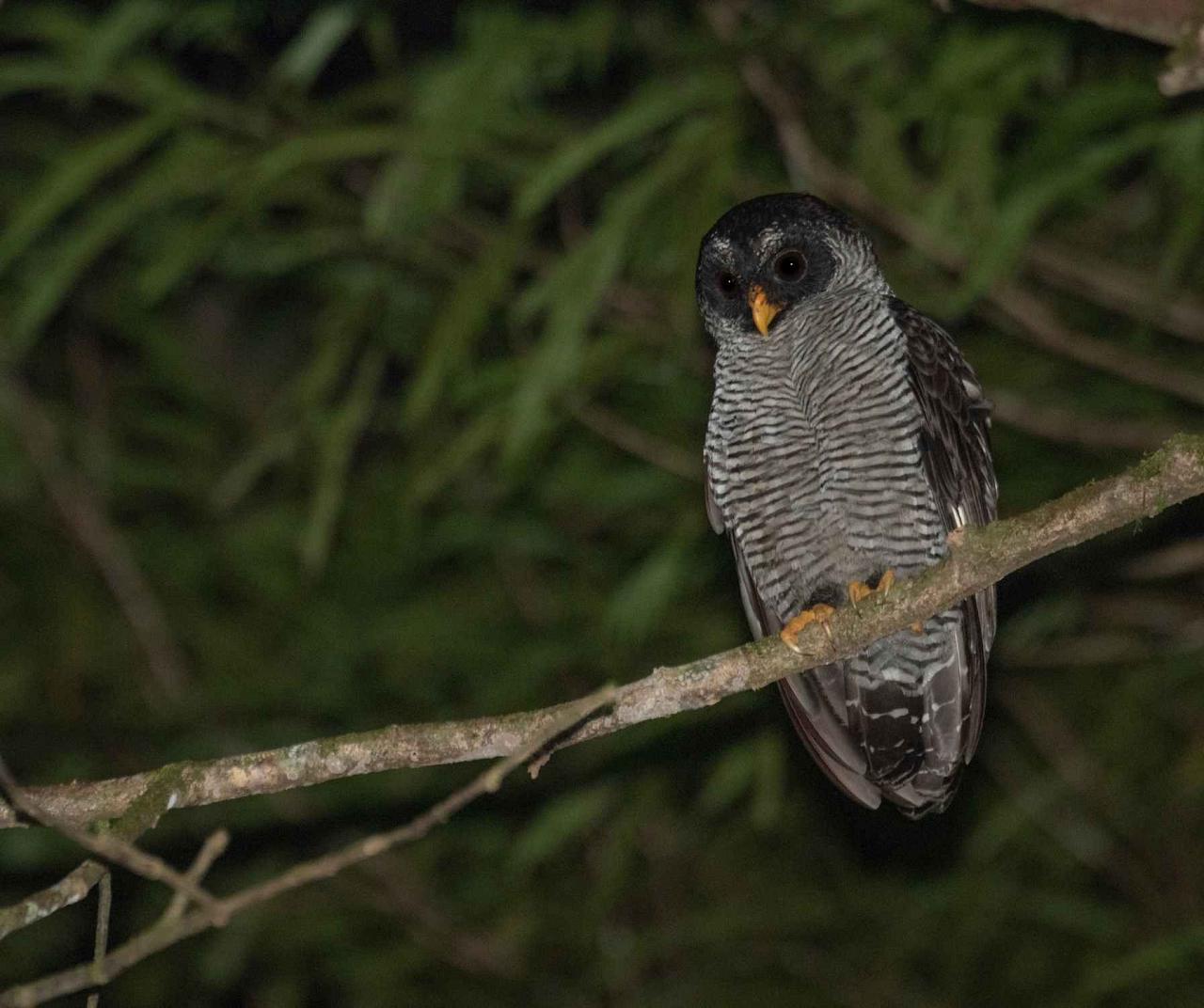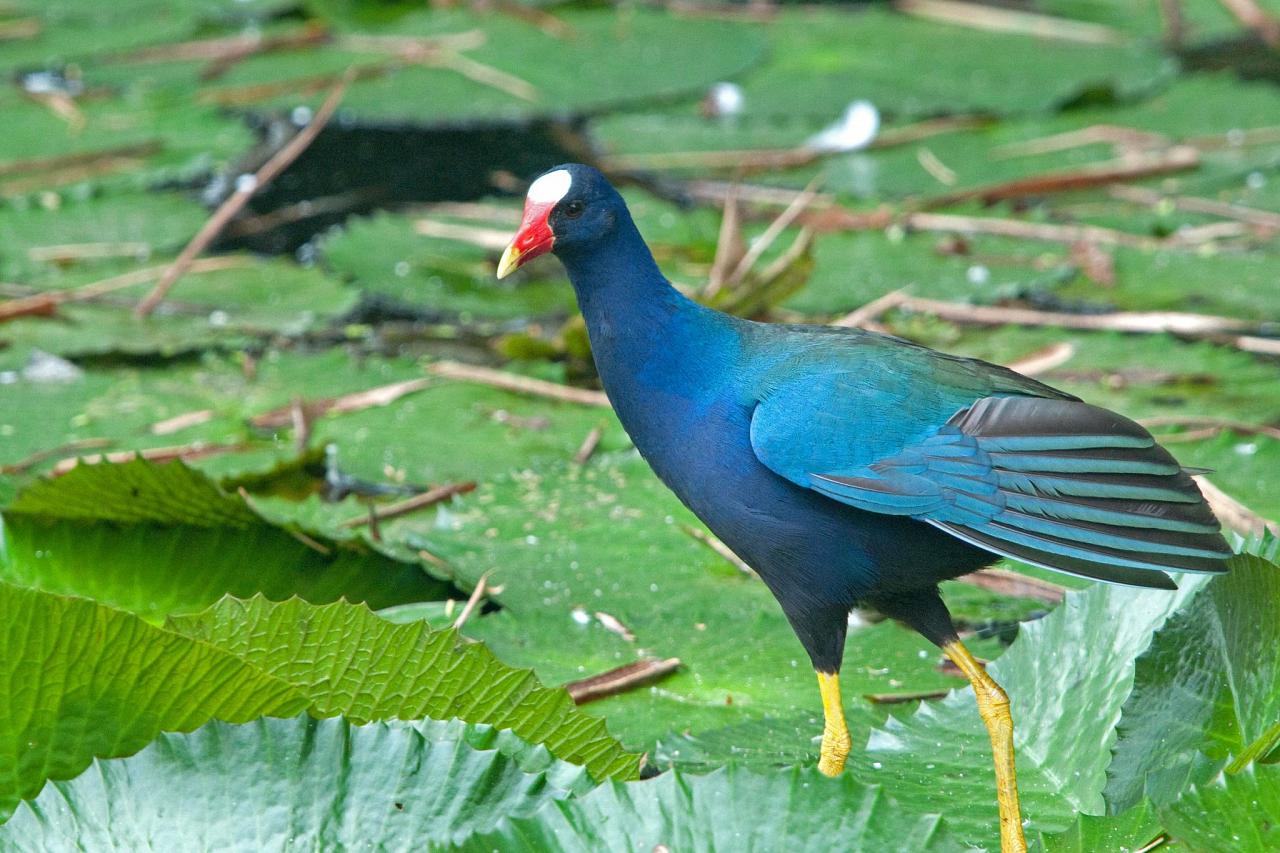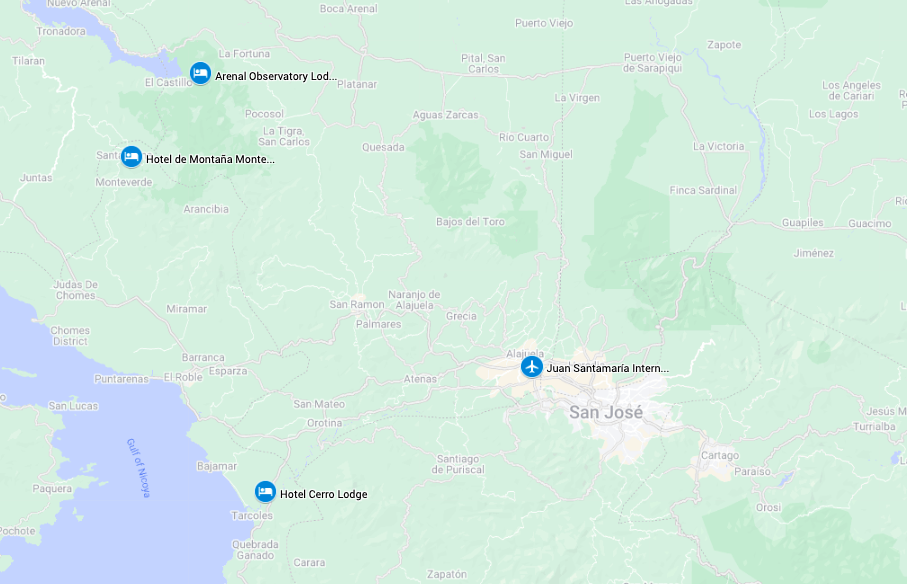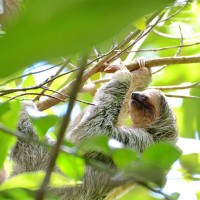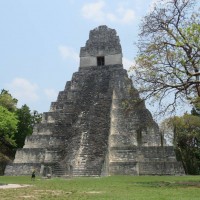- Overview
- Full Itinerary
- Photo Gallery
- Costing
- Travel Details
- Trip Reports
- Guide
- Map
- Know Before You Go
- Other Trips You May Like
Few places rival Costa Rica’s ecological diversity. Over a quarter of the country is protected lands, boasting 850 bird species and 200+ mammals. Why July? Resident birds are just fledging their young, and rains bring life to so many life forms. Afternoon clouds cool down temperatures and we spend time in the mountains!
We visit a wonderful mix of habitats, giving you the chance to see numerous species. Explore the lush Monteverde cloudforest in search of the dazzling Resplendent Quetzal, lovely Long-tailed Manakin, and bizarre Three-wattled Bellbird. Immerse yourself in tropical wonder at Arenal Observatory with a volcano in view and Monteverde Mountain Lodge with birdy and accessible trails. Finally, spend time at Carara National Park near Tarcoles.
Explore both sides of the Continental Divide on this fun summer Costa Rica birding tour—what a great way to immerse yourself in Costa Rica’s stunning biodiversity and observe an exciting list of birds and other wildlife.
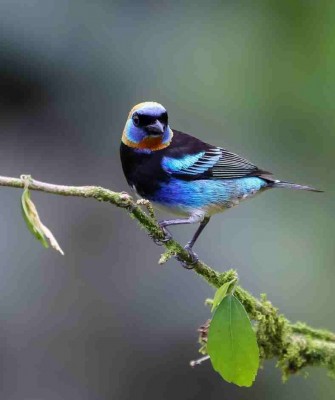



- "Our guide was absolutely outstanding. Extremely knowledgeable - great spotter!, kind, generous, funny. He knows the birds, the country, the field trips, the locations. He had many surprise destinations for us with beautiful scenery and lots of birds." — 2023 Traveler
- "The trip met my expectations exactly. I wanted to see lots of interesting birds and take some pictures, both of which I was able to do...It was extremely well organized and there were no logistical problems at all." — Jim Majure, 2023 Traveler
- "Magical - trip of a lifetime! An amazing exploration of beautiful places that one doesn't often hear about in CR. An abundance and diversity of birds and wildlife." — 2023 Traveler
- "Amazing! If I’d seen a fraction of the birds we saw I would’ve been thrilled..." — 2023 Traveler
- “Experienced Costa Rica from coast to coast. Had amazing guides having incredible knowledge of the birds, wildlife and fauna in Costa Rica. These guys were the best guides I’ve ever had in knowledge of birds, butterflies, habitats and general knowledge of Costa Rica. Also, they were very personable and caring to the participants.” — Caroline DePalma, 2023 Traveler
- “Superb - Birds, Bugs, Blooms, Butterflies and Best Guides! Hard to list all the highlights…Where would I start? The Great Potoo? The American Pygmy Kingfisher? The Three-Wattled Bell Bird? The Hummingbirds? The boat trips. The Eyelash Viper. The Bark Scorpion in our bathroom? How in the name of heavens did Johan and Robert find all those birds? Incredible guides! They kindly adjusted to the varied speeds and limitations of the group members. We were blessed.” — Janet Barrett, 2023 Traveler.
- “A varied and very enjoyable look at several different habitats in a country I knew little about before going there. I had three "target birds" - tiger heron, sun bittern, and swallow-tailed kite - and saw all three of them well. We had two excellent boat trips, on the Cano Negro wetlands and the Tarcoles River estuary. Saw great birds and other wildlife close-up.” — Adrienne Lovelock, 2023 Traveler
Tour Highlights
- Relax at the beautiful Hotel Bougainvillea upon your arrival; bird their 10-acre award winning botanical garden where birds and beautiful sculptures mingle
- Search for hummingbirds, trogons, and mammals too, from Monteverde Mountain Lodge, nestled in lush cloud forest
- View the Arenal Volcano right from your balcony!
- Admire lowland primary rainforest at La Selva Biological Station
- Stay cool up in the mountains—explore Monteverde and Santa Elena Cloud Forest Reserves in search of Resplendent Quetzal, Northern Emerald-Toucanet, Collared Redstart, and Azure-hooded Jay
- Visit famous Carara National Park to see stunning Scarlet Macaw and secretive antbirds




Trip Itinerary
Itineraries are guidelines; variations in itinerary may occur to account for weather, road conditions, closures, etc. and to maximize your experience.
Thurs., July 10 Arrivals in San Jose | Hotel Bougainvillea
Bienvenido a Costa Rica! Please plan to arrive today in San José by 5:00 PM so you can join our welcome dinner and orientation. You are met at the airport for a transfer to our hotel in the hills of the historic suburb of Heredia. The Bougainvillea hotel is a family-owned and operated hotel with a welcoming atmosphere; fresh-cut flowers from the 10-acre garden, and original paintings and sculptures by leading local artists adorn the interior. Massive beamed ceilings, wood paneling, and a fireplace all contribute to the warm feeling of a country inn. And, there are always great birds to greet you as you stroll trails through the garden.
Tonight we gather to enjoy a welcome dinner and the chance to meet your guides and travel companions.
Accommodations at the Hotel Bougainvillea (D)
Fri., July 11 – Sun., July 13 La Selva Biological Station | Arenal Observatory Lodge | La Fortuna
We leave early today to head to the lowlands of Sarapiqui, on our way to Arenal—well worth a stop. Enjoy a visit to one of the world’s premier biological stations as we seek out some extraordinary birds. We’ve even seen Great Tinamou nesting here!
We then travel west to La Fortuna. At an elevation of about one thousand feet, we settle in to awesome digs at Arenal Observatory Lodge and and enjoy visits to the nearby town of La Fortuna feature Caribbean foothill rainforest. Due to the perpetually mild and wet climate, this habitat is particularly rich in fruit-eating birds such as toucans, oropendolas, and tanagers. Ant swarms are also a big feature. Most of Costa Rica's obligate antbirds inhabit the understory of this rainforest.
Arenal Observatory Lodge is a particularly comfortable lodge from which to explore this habitat. There is a beautiful terrace that looks upon the currently dormant Arenal Volcano and an elaborate set of fruit feeders. Collared Aracari, Yellow-throated Toucan, Montezuma Oropendola, and Black-cheeked Woodpecker all squabble over the tasty morsels of papaya, banana, and other fruit on offer. Once the larger birds have had their fill, tanagers such as Crimson-collared, Emerald, and Bay-headed often make a pass at the fruit.
On the forest floor, there is often Gray-chested Dove, Black-striped Sparrow, and Great Curassow picking off the scraps from above. The lodge grounds also feature lovely flower gardens and thoughtfully placed fruiting trees (mostly Ficus), which attract many birds from the surrounding forest. Row upon row of flowering blue porterweed attract Black-crested Coquette, Brown Violetear, Green Thorntail, Violet-headed Hummingbird, and Bronze-tailed Plumeleteer. Wide, carefully maintained, and gently sloping forest trails offer fantastic birding opportunities. Every day is different—even every hour is different! Some of the birds that regularly make an appearance include Dull-mantled Antbird, Thicket Antpitta, Broad-billed Motmot, Semiplumbeous Hawk, and Black-and-yellow Tanager. For those that happen upon an ant swarm, antbird species such as Bicolored, Spotted, and Ocellated Antbird are possible.
During our days here, we explore both in and around the lodge grounds and take local, off-site field trips too. Outside the grounds of Arenal Observatory Lodge, the entrance road and nearby national park offer great birding. White-faced Nunbird, Slaty-tailed Trogon, Rufous Mourner, and Long-tailed Tyrant are all regular along the 'peninsula road.' The more open pastures can have the spectacular White-throated Magpie-Jay, a species usually associated with the dry forests of the Guanacaste region. The small river that crosses underneath the road often has Black Phoebe and (for those who are lucky) Bare-throated Tiger-Heron.
Down at La Fortuna, Sendero Bogarin features secondary growth forest crisscrossed by streams. The birds here are similar but different from those found at Arenal Observatory Lodge. Uniform Crake, White-throated Crake, and Russet-naped Wood-Rail are all common here, although they are not always easy to see. The brushy thickets hold several territories of Black-throated Wren, Fasciated Antshrike, Keel-billed Motmot, and Rufous-tailed Jacamar. Among flocks of tanagers, one sometimes finds the tiny Olivaceous Piculet, the smallest woodpecker in North America. The owner of the property often has a staked out Black-and-white Owl roost, as well as multiple spots to look for both Brown-throated Three-toed and Hoffmann's Two-toed Sloths. After birding here, there is a nice chocolate shop in town with locally sourced chocolate, coffee, and fresh baked goods!
We also enjoy some prized feet-up on the balcony of your room time, looking off to the volcano ….
Accommodations at Arenal Observatory Lodge (B,L,D)
Mon., July 14 Higher into the Mountains | Monteverde | Children’s Eternal Rainforest
We leave Arenal this morning for another fabled Costa Rican destination. Traveling up a gradient of elevation allows us to bird in varied habitats—great fun!
Monteverde is a treasured location in Costa Rica where many birders get their first feel for birding lush montane forests. Remote, Monteverde has retained its charm despite its popularity and is still an excellent place for birding. We stay three nights to access several reserves. Plus, we have great birding right outside our door on the lodge grounds!
Our hotel, the Monteverde Mountain Hotel, sits amongst 15 acres of private forest at 4,500 feet above sea level. This mountain hotel has cozy rooms set in nicely kept grounds and features hummingbird feeders at the veranda.
This afternoon, we enjoy birding the Children’s Eternal Rainforest, a special place. We may see Rufous-capped Warbler, Rufous-and-white Wren, and with some luck more elusive species like Northern Barred-Woodcreeper and Orange-billed Nightingale Thrush.
Watch for Swallow-tailed Kite on the move overhead in the late afternoon. Our dinner is well-prepared local Costa Rican food at the hotel.
Accommodations at the Monteverde Mountain Hotel (B,L,D)
Tues., July 15 Monteverde Cloudforest Reserve | Curicancha Reserve
This morning we visit the famous Monteverde Cloud Forest Reserve, one of the best places to find Resplendent Quetzal. Other lush highland forest species include Black Guan, Gray-breasted Wood Wren, Black-faced Solitaire, and with luck Silvery-fronted Tapaculo. Monteverde is a great place to spy a mixed flock, with Spotted Barbtail, Buffy Tuftedcheek, and Ruddy Treerunner probing bromeliads and mossy tree limbs while Spangle-cheeked Tanager search for fruit in the canopy. This place is also wonderland for botany fans.
This afternoon we visit Curicancha Reserve, a small reserve (200 acres) but a true gem. Here, we get another chance to see Resplendent Quetzal, alongside Three-wattled Bellbird, Collared Trogon, Gray-throated Leaftosser, and other species. At hummingbird feeders, we may add Purple-throated Mountain-gem, Green-crowned Brilliant, Violet Sabrewing, and Magenta-throated Woodstar. With luck we could find mammals, too: Hoffmann’s Two-toed Sloth, Mantled Howler Monkey, White-faced Capuchin, or Kinkajou.
Accommodations at the Monteverde Mountain Hotel (B,L,D)
Wed., July 16 Santa Elena Cloud Forest Reserve
This morning, we visit a reserve that is less well-known than Monteverde but has equally stunning and diverse forests. Encompassing approximately 730 acres, the Santa Elena Cloud Forest Reserve was established in 1992 through the combined initiatives of the Santa Elena Community High School and Canadian-based Youth Challenge International.
During our time in this verdant reserve, we scan the moss-laden trees for regional endemics such as Collared Redstart, Black Guan, and Collared Trogon, while also paying close attention to the trail ahead of us for secretive ground-dwelling species such as Buff-fronted Quail-Dove and Black-breasted Wood-Quail. However, the true stars of this forest are the incomparably beautiful Resplendent Quetzal, a contender for most beautiful bird of the world, and the bizarre Three-wattled Bellbird, the source of a call that rings throughout the cloud forest during this time of the year. Both should have fledgling young at this time and are rewarding to find and watch.
Other species we hope to see include Northern Emerald-Toucanet, Prong-billed Barbet, Chestnut-capped Brushfinch, Costa Rican Warbler, and Golden-browed Chlorophonia. Be sure to watch for Orange-kneed Tarantula!
Best of all, in addition to trails, there are feeders, where Green Hermit, Green-crowned Brilliant, Purple-throated Mountain-gem, Magenta-throated Woodstar, Violet Sabrewing, Stripe-tailed Hummingbird, and Coppery-headed Emerald all put on a show.
Enjoy the afternoon to check out the local butterfly gardens, or some may wish to see artisan shops in the town of Monteverde. We have a celebratory final dinner tonight is at the lodge.
Accommodations at the Monteverde Mountain Hotel (B,L,D)
Thurs., July 17 Departures
After breakfast this morning we say goodbye and transfer back to San José’s Juan Santamaría International Airport to take your flights back home. This is nearly a three hour drive, so in order not to rush this morning, please plan to make flights out after 2:00 PM. (B)
Cost of the Journey
Cost of the journey is per person, based on occupancy: $3990 DBL / $4820 SGL, from San José, Costa Rica. Cost includes seven nights’ accommodations, all meals as noted in the itinerary, airport transfers, ground transportation, professional guide services, park and other entrance fees, and miscellaneous program expenses. Not included is round-trip airfare to and from San José, personal expenses such as laundry, telephone, drinks from the bar, and gratuities for luggage handling or other services. Guide gratuities are at your discretion.
Travel Details
Please plan to make air travel plans only after the minimum group size has been met. We will send you a confirmation email as soon as the trip has been confirmed.
Arrival and Departure Airport: Juan Santamaria International Airport (SJO) in San Jose
Arrival Details: Please plan flights to arrive July 10, 2025 no later than 5:00 PM if you wish to join the group for dinner.
Departure Details: Please plan flight departures on July 17, 2025 after 2:00 PM. If you would prefer to overnight in San Jose for a morning departure on July 18, 2025, we have an airport hotel recommendation below.
Travel Tips: If you arrive early to rest up from your travels, we can book extra nights for you with a transfer to our hotel, the Hotel Bougainvillea, which is in a residential area of the city. If you prefer to stay downtown and see the city, we have listed a few hotel recommendations below. If you choose to stay downtown, you’ll need to arrange a taxi or driver with the hotel to return to the airport for pickup or go out to the Bougainvillea to enjoy its gardens on the tour start date. There are many things to see in San Jose if you’re up for exploring! If you enjoy museums, you’re in luck because some of the best in Costa Rica are located right in San Jose. The Museo Nacional de Costa Rica has exhibits highlighting the archaeology and history of Costa Rica as well as a butterfly garden. The Pre-Columbian Gold Museum has one of the largest collections of gold artifacts in Latin America, some of which date back to 500 CE. If you’re looking to do some shopping or try some local food, head over to the Mercado Central (Central Market). You’ll find vendors selling fruits and vegetables, local food dishes, and a wide variety of souvenirs.
Downtown Hotel Recommendations: Hotel Presidente Hotel Grano de Oro
Airport Hotel Recommendations: Doubletree by Hilton Hotel Cariari San Jose
Entry Requirements: See "Essential Information" section under the "Know Before You Go" tab.
Browse below for trip reports and species lists from past versions of this and other tours from this destination.
Costa Rica
- January 2018
- October 2018
- January 2019
- March 2019
- January 2020
- March 2021
- December 2021 (Christmas in Costa Rica)
- February 2022
- March 2022
- December 2022
- January 2023
- February 2023
- July 2023
- October 2023
- December 2023 (Christmas Tour)
- January 2024
- February 2024
- July 2024
Monteverde
- March 2022
- March 2023
- March 2024
Northern
- March 2012
- January 2013
- January 2017
Southern
- February 2007
- January 2017
- January 2018
- January 2019
- February 2023
-
James P. Smith

James brings some twenty five years of guiding experience to Naturalist Journeys. Originally from Sheffield in the United Kingdom, he discovered a love for guiding in Israel in 1995 where he helped establish the Kibbutz Lotan Center for Birdwatching in the Southern Arava Valley. Since then, he’s led hundreds of tours throughout the Northern Hemisphere for a number of UK-based tour companies. His trips to Israel and North America are especially close to his heart but he’s also led or co-led tours to Mexico (Veracruz), The Gambia, Kenya, Iceland, Scottish Highlands, Spanish Pyrenees, Central/Southern France, Greece (Lesvos), and India (Goa). An accomplished illustrator, James placed runner-up in the British Birds “Bird Illustrator of the Year” competition in 1992 and went on to have his work published in numerous birding magazines and journals. He also co-authored the two volume set A Guide to the Birding Hotspots of Israel (Published in 2000 by the Israel Ornithological Center and the S.P.N.I.). He returns to Israel every year to lead trips and remains an active member of the Israel Rarities and Distribution Committee. When not leading tours he can be found at home in Western Massachusetts with his wife Susannah and their young son Matan.
Other trips with James P. Smith
-
 Western Panama: Tranquilo Bay CLOSED - Check out Lesser Antilles Endemics in December!November 9 - 16, 2024, w/Mt. Totumas extension
Western Panama: Tranquilo Bay CLOSED - Check out Lesser Antilles Endemics in December!November 9 - 16, 2024, w/Mt. Totumas extension -
 Oaxaca Valley: Birds, Culture & CraftsDecember 1 - 9, 2024
Oaxaca Valley: Birds, Culture & CraftsDecember 1 - 9, 2024 -
 Trinidad & Tobago: Incredible Birds & Wildlife FULL - See our April departure!January 16 - 25, 2025
Trinidad & Tobago: Incredible Birds & Wildlife FULL - See our April departure!January 16 - 25, 2025 -
 Belize: Three Great Lodges FULL - Check out Best of Belize in February!February 19 - March 1, 2025
Belize: Three Great Lodges FULL - Check out Best of Belize in February!February 19 - March 1, 2025 -
 Best of Belize FULL - Check out Belize: Birds & Beaches!March 2 - 10, 2025
Best of Belize FULL - Check out Belize: Birds & Beaches!March 2 - 10, 2025 -
 Guyana: Unspoiled WildernessMarch 27 - April 8, 2025
Guyana: Unspoiled WildernessMarch 27 - April 8, 2025 -
 Cape May: Spring MigrationMay 13 - 19, 2025
Cape May: Spring MigrationMay 13 - 19, 2025 -
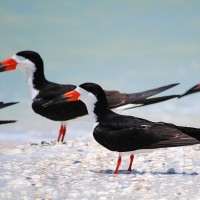 Cape May: Fall MigrationOctober 14 - 20, 2025
Cape May: Fall MigrationOctober 14 - 20, 2025 -
 Belize: Three Great LodgesNovember 2 - 12, 2025
Belize: Three Great LodgesNovember 2 - 12, 2025 -
 South Texas Birding & NatureDecember 3 - 11, 2025
South Texas Birding & NatureDecember 3 - 11, 2025
-
Essential Information +
Pace & Protocols +
Packing List +
Suggested Reading List +
Useful Links +
Photo credits: Banner: Black-cheeked Woodpecker by Greg Smith (GS); Lizard by Sandy Sorkin; Monteverde Suspension bridge; Squirrel Cuckoo by Sandy Sorkin; Keel-billed Toucan by Doug Greenberg (DG); Black Howler Monkey by Peg Abbott (PA); Gallery: Collared Aracari; Arenal Volcano; Black-and-white Owl; Giant Anteater, Naturalist Journeys Stock; Purple Gallinule, Tom Dove; Purple-throated Mountain Gem, GS; Savegre Bromeliads, GS; Chestnut-colored Woodpecker, SS. Primary Thumbnail: Birding, Karen Holmen; Montezuma Oropendola, Anindya Sen; Golden-hooded Tanager, White-faced Capuchin, John Trezise Secondary: Hoffman’s Two-toed Sloth, Emerald Toucanet, Scarlet Macaw, Rainforest Northern Barred Woodcreeper Phil Yates, courtesy Operador Latino; Black Guan, DG; Lesson's Motmot, Mike Boyce; Central American Squirrel Monkey, PA; View from Celeste Mountain Lodge, celestemountainlodge.com; Collared Aracari, James Adams; Red-legged Honeycreeper, GS; Great Curassow, SS;










